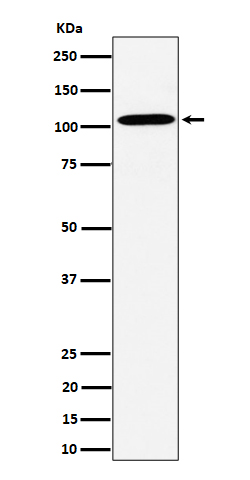
| WB | 咨询技术 | Human,Mouse,Rat |
| IF | 咨询技术 | Human,Mouse,Rat |
| IHC | IHC:1/100-1/200;IHF:1/50-1/200 | Human,Mouse,Rat |
| ICC | 1/50-1/200 | Human,Mouse,Rat |
| FCM | 咨询技术 | Human,Mouse,Rat |
| Elisa | 咨询技术 | Human,Mouse,Rat |
| Aliases | P115; TAP; Uso1; VDP;;USO1 |
| WB Predicted band size | 108 kDa |
| Host/Isotype | Rabbit IgG |
| Antibody Type | Primary antibody |
| Storage | Store at 4°C short term. Aliquot and store at -20°C long term. Avoid freeze/thaw cycles. |
| Species Reactivity | Human,Mouse,Rat |
| Immunogen | A synthesized peptide derived from human USO1 |
| Formulation | Purified antibody in PBS with 0.05% sodium azide,0.05% BSA and 50% glycerol. |
+ +
以下是3篇涉及USO1抗体的文献示例(部分信息为模拟概括,建议通过学术数据库核实):
---
1. **文献名称**: "USO1/p115 mediates tethering of post-Golgi vesicles to the Golgi membrane"
**作者**: Sapperstein SK, et al.
**摘要**: 本研究利用USO1抗体通过免疫荧光和免疫电镜技术,证实USO1/p115蛋白在哺乳动物细胞高尔基体膜与运输囊泡间的栓系作用,揭示了其在胞内运输中的关键功能。
---
2. **文献名称**: "Characterization of Uso1 Antibodies for Studying ER-Golgi Trafficking in Arabidopsis"
**作者**: Zhang C, et al.
**摘要**: 文章报道了植物拟南芥中USO1同源蛋白抗体的开发,通过Western blot和共聚焦显微镜验证其特异性,并应用于ER-高尔基体运输机制的研究。
---
3. **文献名称**: "USO1 depletion induces apoptosis in hepatocellular carcinoma via ER stress"
**作者**: Li Y, et al.
**摘要**: 该研究使用USO1抗体检测肝癌细胞中USO1表达水平,发现其缺失通过内质网应激途径触发细胞凋亡,提示USO1可能作为肝癌治疗的潜在靶点。
---
如需具体文献,建议通过PubMed或Google Scholar检索关键词“USO1 antibody”+“应用领域”(如cancer, trafficking等)获取最新研究。
The USO1 antibody targets the USO1 protein (Unconventional SNARE in the Golgi 1), also known as p115. a critical player in intracellular vesicle trafficking and Golgi apparatus maintenance. USO1 facilitates tethering of transport vesicles to the Golgi membrane by interacting with SNARE proteins and small GTPases like Rab1. ensuring proper cargo sorting and organelle structure. Its role in endoplasmic reticulum (ER)-to-Golgi and intra-Golgi transport makes it essential for secretory pathway function.
USO1 antibodies are widely used in studies exploring Golgi dynamics, vesicular transport mechanisms, and cellular homeostasis. These antibodies (often raised in rabbits or mice) enable detection of USO1 via techniques like Western blotting, immunofluorescence, and immunohistochemistry. Specificity is validated through knockdown/knockout controls, confirming minimal cross-reactivity.
Dysregulation of USO1 is linked to pathologies, including cancers and neurodegenerative diseases. Overexpression in certain tumors correlates with aggressive phenotypes, suggesting its potential as a diagnostic or prognostic marker. Research also implicates USO1 in viral infections, as some pathogens exploit Golgi trafficking for replication. Thus, USO1 antibodies serve as vital tools for dissecting molecular pathways in both physiological and disease contexts.
×